- الرئيسية
- معلومات عنا
- صناعة
- الخدمات
- قراءة
- اتصل بنا
سوق السفن الكهربائية: التحليل الحالي والتوقعات (2024-2032)
التركيز على النوع (محطة توليد كهرباء تعمل بالنفط ومحطة توليد كهرباء تعمل بالغاز)؛ التطبيق (مدني وعسكري)؛ والمنطقة/الدولة
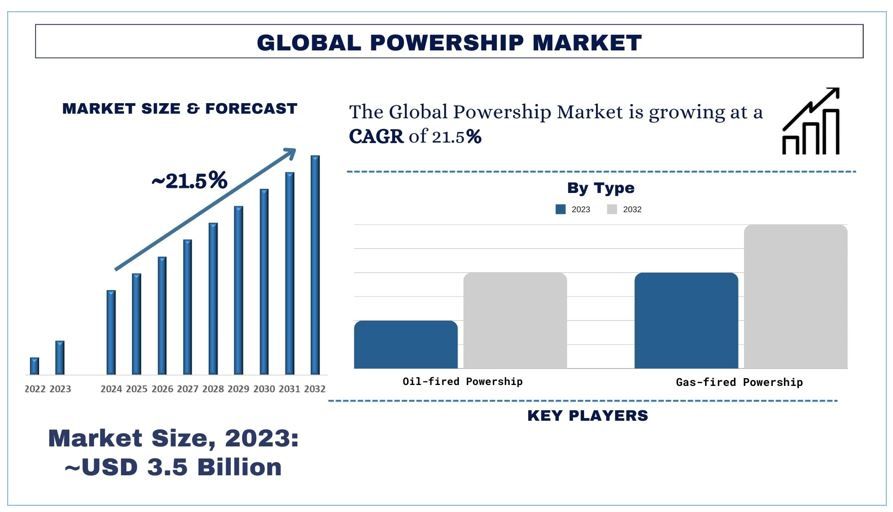 حجم سوق محطات الطاقة العائمة وتوقعاته
حجم سوق محطات الطاقة العائمة وتوقعاته
بلغت قيمة سوق محطات الطاقة العائمة ما يقرب من 3.5 مليار دولار أمريكي في عام 2023، ومن المتوقع أن ينمو بمعدل نمو سنوي مركب قوي يبلغ حوالي 21.5٪ خلال الفترة المتوقعة (2024-2032) بسبب الطلب العالمي المتزايد على الكهرباء.
تحليل سوق محطات الطاقة العائمة
تم تصميم محطة الطاقة العائمة لتوفير الطاقة والدعم لمحطة توليد الكهرباء لأنها تعمل كمصدر للطاقة للكهرباء. تُستخدم هذه السفن للخضوع للتحول لتوليد الطاقة أو يمكنها استيراد محطات الطاقة إلى السفن البحرية الأخرى. يتم ذلك بهدف ضمان وجود طاقة كهربائية كافية لتلبية الاحتياجات المتوقعة في المستقبل. في الآونة الأخيرة، تم إنشاء محطات طاقة ذاتية الدفع، وربما لهذا السبب، يمكن نشرها في الدول النامية. يمكن تركيبها في أي شبكة قطرية حسب المتطلبات دون عامل تقييد صارم. تُعرف محطات الطاقة العائمة أيضًا باسم ص bargات الطاقة وقد تكون إما ثابتة تمامًا أو راسية بشكل دائم في ميناء نهري. يشار إليها أيضًا باسم "ص bargات الطاقة" أو "محطات الطاقة المتنقلة" في بعض الأحيان.
يتوسع سوق محطات الطاقة العائمة حول العالم بشكل كبير لأن الدول في طلب أعلى على الكهرباء المتنقلة الفعالة. على سبيل المثال، وفقًا للمراجعة الإحصائية لشركة BP للطاقة العالمية، 2021، ارتفع الطلب العالمي على الطاقة الأولية بنسبة 6٪ مع ارتفاع توليد الكهرباء بنسبة 6.2٪. يرجع نمو هذا السوق إلى الزيادة في متطلبات الطاقة للدول النامية، والزيادة في أهمية النشر السريع لأنظمة الطاقة الشمسية الكهروضوئية في مناطق الكوارث، والانجراف العالمي نحو الطاقة النظيفة. وفي نفس السياق، فإن محطة الطاقة العائمة ميسورة التكلفة أيضًا ويمكن بناؤها بكميات كبيرة دون الحاجة إلى استثمار مكلف في البنية التحتية. نظرًا لأن الهندسة أصبحت قادرة على صنع محطات طاقة عائمة فعالة تتسم بالكفاءة والمقبولة للبيئة، فإنها تتخذ تدريجياً دورًا استراتيجيًا في توفير طاقة مؤقتة وأساسية في أجزاء مختلفة من العالم.
اتجاهات سوق محطات الطاقة العائمة
يناقش هذا القسم اتجاهات السوق الرئيسية التي تؤثر على قطاعات سوق محطات الطاقة العائمة كما حددها خبراء البحث لدينا.
نوع محطات الطاقة العائمة التي تعمل بالغاز تحول الصناعة
من المتوقع أن تنمو محطات الطاقة العائمة التي تعمل بالغاز بمعدل نمو سنوي مركب كبير في الفترة المتوقعة (2024-2032). تطورت محطات الطاقة العائمة تدريجياً وهي الآن تعمل في الغالب بالغاز ويتم اعتمادها في السوق العالمية. تشمل العديد من العوامل التي ساهمت في هذا الاتجاه زيادة التركيز على انبعاثات الكربون وعوامل التكلفة حيث يكون الغاز الطبيعي أرخص نسبيًا وأكثر كفاءة مقارنة بالنفط. توجد محطات طاقة عائمة تعمل بالغاز ولا تزال مفيدة لأن التحول إلى استخدام الطاقات الخضراء هو اتجاه شائع في جميع أنحاء العالم. على سبيل المثال، تخطط حكومة جنوب إفريقيا لإطلاق عملية شراء لـ 3000 ميجاوات من توليد الطاقة بالغاز. أيضًا، فإن التطورات المتزايدة للغاز الطبيعي وزيادة توافر الغاز الطبيعي المسال جعلت استخدام الغاز خيارًا قابلاً للتطبيق. هذه هي العوامل التي تجعل محطات الطاقة العائمة التي تعمل بالغاز شائعة من حيث مصادر الطاقة الموثوقة والفعالة والنظيفة والمستدامة.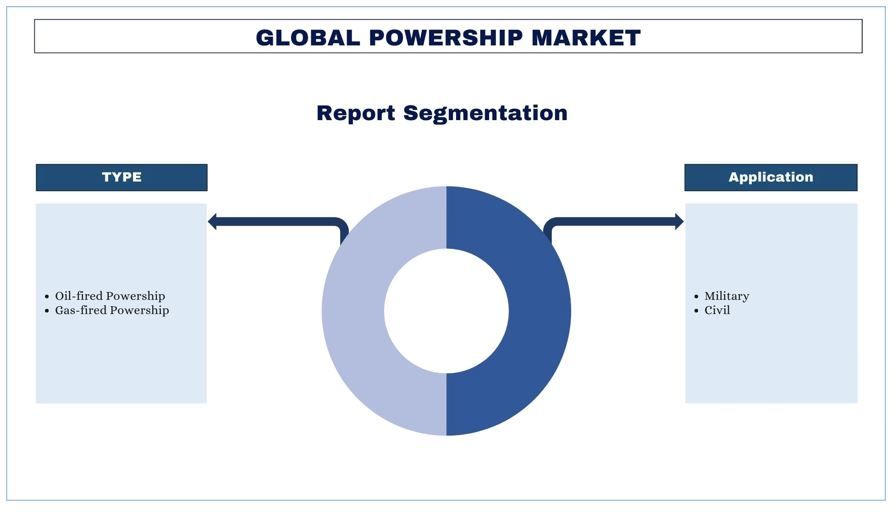
من المتوقع أن تنمو منطقة آسيا والمحيط الهادئ بمعدل نمو سنوي مركب كبير خلال الفترة المتوقعة
تمتلك منطقة آسيا والمحيط الهادئ حصة سوقية كبيرة. يوجد حتى الآن ما يقرب من 100 سفينة طاقة عاملة على مستوى العالم. تلعب هذه السفن، التي يتم وضعها بشكل استراتيجي، دورًا محوريًا في استكمال شبكة الطاقة في مناطق مختلفة. تتصدر آسيا بـ 40 سفينة طاقة، تليها إفريقيا بـ 25 سفينة. تستضيف أوروبا وأمريكا الجنوبية 15 سفينة لكل منهما، بينما تمتلك أمريكا الشمالية وأوقيانوسيا 5 سفن لكل منهما. تساهم محطات الطاقة العائمة هذه بما يقرب من 5٪ من حلول الطاقة الطارئة في العالم، وهو دليل على أهميتها المتزايدة.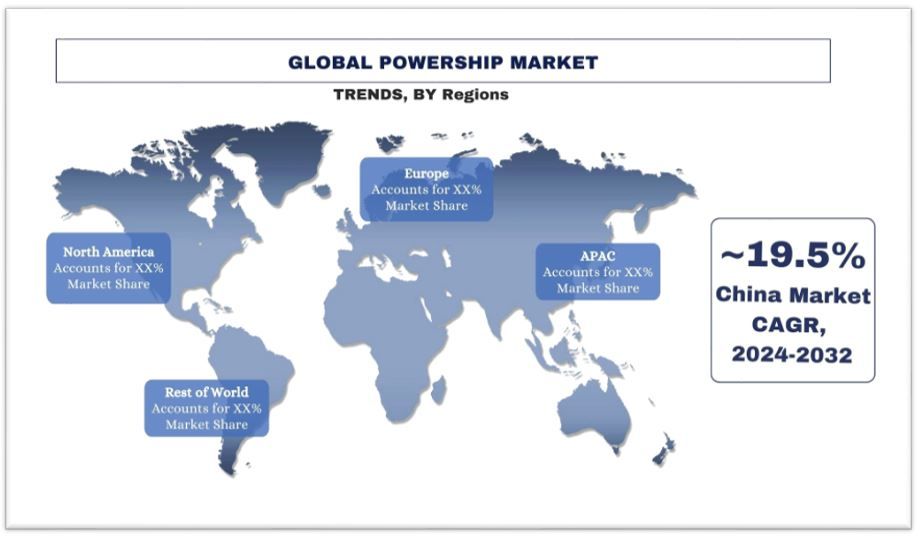
نظرة عامة على صناعة محطات الطاقة العائمة
سوق محطات الطاقة العائمة تنافسي، مع وجود العديد من اللاعبين العالميين والدوليين في السوق. يتبنى اللاعبون الرئيسيون استراتيجيات نمو مختلفة لتعزيز تواجدهم في السوق، مثل الشراكات والاتفاقيات والتعاون وإطلاق المنتجات الجديدة والتوسعات الجغرافية وعمليات الاندماج والاستحواذ. بعض اللاعبين الرئيسيين العاملين في السوق هم ABB و Komarine Co و General Electric Company و Karpowership و Mitsui O.S.K Lines و Becker Marine Systems و Wartsila و Norwegian Electric Systems و Corvus Energy و MAN Energy.
أخبار سوق محطات الطاقة العائمة
في عام 2023، وقعت Karpowership مذكرة تفاهم مع JSC Energy Co. في أوكرانيا (ECU) يمكن أن تتضمن عمليات نشر سريعة لمحطات طاقة بحرية عائمة لمعالجة أزمة الطاقة في البلاد.
في يناير 2020، وقعت Bloom Energy (NYSE: BE) و Samsung Heavy Industries (SHI)، وهي جزء من مجموعة Samsung، اتفاقية تطوير مشتركة (JDA) لتصميم وتطوير السفن التي تعمل بخلايا الوقود. ستعمل الشركتان معًا لتحقيق رؤيتهما المتمثلة في الطاقة النظيفة للسفن وصناعة الشحن البحري الأكثر استدامة.
تغطية تقرير سوق محطات الطاقة العائمة
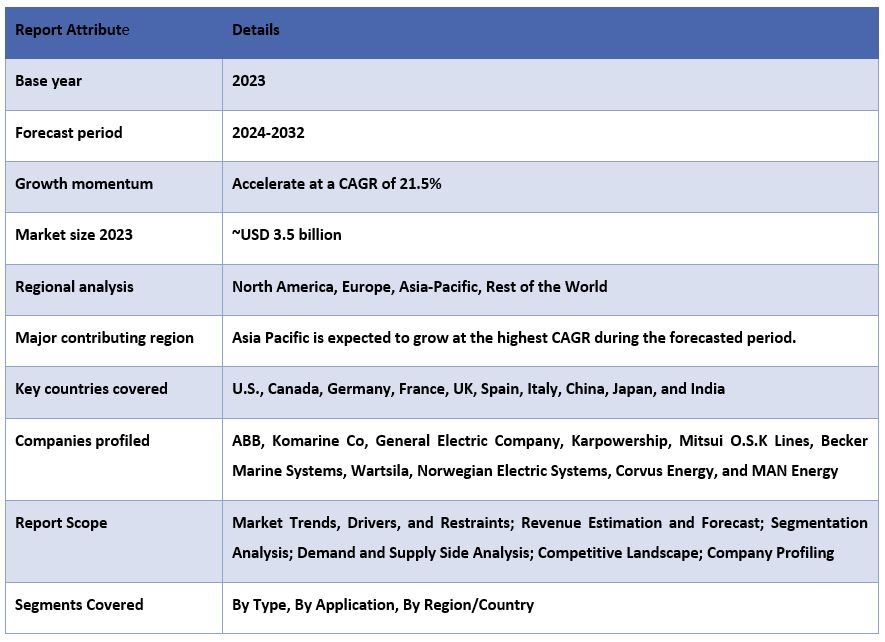
أسباب شراء هذا التقرير:
- تتضمن الدراسة تحليلًا لحجم السوق وتوقعاته تم التحقق منه من قبل خبراء الصناعة الرئيسيين الموثوق بهم.
- يقدم التقرير مراجعة سريعة للأداء العام للصناعة في لمحة.
- يغطي التقرير تحليلًا متعمقًا لأقران الصناعة البارزين مع التركيز الأساسي على البيانات المالية الرئيسية للأعمال، ومحافظ المنتجات، واستراتيجيات التوسع، والتطورات الأخيرة.
- فحص تفصيلي للدوافع والقيود والاتجاهات الرئيسية والفرص السائدة في الصناعة.
- تغطي الدراسة بشكل شامل السوق عبر قطاعات مختلفة.
- تحليل متعمق على المستوى الإقليمي للصناعة.
خيارات التخصيص:
يمكن تخصيص سوق محطات الطاقة العائمة العالمي بشكل أكبر وفقًا للمتطلبات أو أي قطاع سوق آخر. إلى جانب ذلك، تدرك UMI أن لديك احتياجات عمل خاصة بك؛ وبالتالي، لا تتردد في التواصل معنا للحصول على تقرير يناسب متطلباتك تمامًا.
جدول المحتويات
منهجية البحث لتحليل سوق السفن الكهربائية (2022-2032)
كان تحليل السوق التاريخي وتقدير السوق الحالي والتنبؤ بالسوق المستقبلي لسوق السفن الكهربائية العالمي هي الخطوات الرئيسية الثلاث التي تم اتخاذها لإنشاء وتحليل اعتماد السفن الكهربائية في المناطق الرئيسية على مستوى العالم. تم إجراء بحث ثانوي شامل لجمع أرقام السوق التاريخية وتقدير حجم السوق الحالي. ثانيًا، تم أخذ العديد من النتائج والافتراضات في الاعتبار للتحقق من صحة هذه الرؤى. علاوة على ذلك، تم إجراء مقابلات أولية شاملة أيضًا مع خبراء الصناعة عبر سلسلة القيمة لسوق السفن الكهربائية العالمي. بعد افتراض أرقام السوق والتحقق من صحتها من خلال المقابلات الأولية، استخدمنا نهجًا من أعلى إلى أسفل/من أسفل إلى أعلى للتنبؤ بحجم السوق الكامل. بعد ذلك، تم اعتماد أساليب تقسيم السوق وتثليث البيانات لتقدير وتحليل حجم السوق للقطاعات والقطاعات الفرعية في الصناعة. المنهجية التفصيلية موضحة أدناه:
تحليل حجم السوق التاريخي
الخطوة 1: دراسة متعمقة للمصادر الثانوية:
تم إجراء دراسة ثانوية تفصيلية للحصول على حجم السوق التاريخي لسوق السفن الكهربائية من خلال مصادر الشركة الداخلية مثل التقارير السنوية والبيانات المالية وعروض الأداء والنشرات الصحفية وما إلى ذلك، والمصادر الخارجية بما في ذلك المجلات والأخبار والمقالات والمنشورات الحكومية ومنشورات المنافسين وتقارير القطاعات وقاعدة بيانات الطرف الثالث والمنشورات الموثوقة الأخرى.
الخطوة 2: تقسيم السوق:
بعد الحصول على حجم السوق التاريخي لسوق السفن الكهربائية، أجرينا تحليلًا ثانويًا مفصلاً لجمع رؤى السوق التاريخية وحصص القطاعات والقطاعات الفرعية المختلفة للمناطق الرئيسية. يتم تضمين القطاعات الرئيسية في التقرير، مثل النوع والتطبيق والمناطق. تم إجراء المزيد من التحليلات على مستوى الدولة لتقييم الاعتماد الكلي لنماذج الاختبار في تلك المنطقة.
الخطوة 3: تحليل العوامل:
بعد الحصول على حجم السوق التاريخي للقطاعات والقطاعات الفرعية المختلفة، أجرينا تحليلًا تفصيليًا للعوامل لتقدير حجم السوق الحالي لسوق السفن الكهربائية. علاوة على ذلك، أجرينا تحليلًا للعوامل باستخدام متغيرات تابعة ومستقلة مثل النوع والتطبيق ومناطق سوق السفن الكهربائية. تم إجراء تحليل شامل لسيناريوهات جانب الطلب والعرض مع الأخذ في الاعتبار أهم الشراكات وعمليات الدمج والاستحواذ والتوسع التجاري وإطلاق المنتجات في قطاع سوق السفن الكهربائية في جميع أنحاء العالم.
تقدير حجم السوق الحالي والتنبؤ به
تقدير حجم السوق الحالي: بناءً على رؤى قابلة للتنفيذ من الخطوات الثلاث المذكورة أعلاه، توصلنا إلى حجم السوق الحالي واللاعبين الرئيسيين في سوق السفن الكهربائية العالمي والحصص السوقية للقطاعات. تم تحديد جميع الحصص المئوية المطلوبة وتقسيمات السوق باستخدام النهج الثانوي المذكور أعلاه وتم التحقق منها من خلال المقابلات الأولية.
التقدير والتنبؤ: لتقدير السوق والتنبؤ به، تم تخصيص أوزان لعوامل مختلفة بما في ذلك المحركات والاتجاهات والقيود والفرص المتاحة لأصحاب المصلحة. بعد تحليل هذه العوامل، تم تطبيق تقنيات التنبؤ ذات الصلة، أي النهج من أعلى إلى أسفل/من أسفل إلى أعلى، للوصول إلى توقعات السوق لعام 2032 للقطاعات والقطاعات الفرعية المختلفة عبر الأسواق الرئيسية على مستوى العالم. تشمل منهجية البحث المعتمدة لتقدير حجم السوق ما يلي:
- حجم سوق الصناعة، من حيث الإيرادات (بالدولار الأمريكي) ومعدل اعتماد سوق السفن الكهربائية عبر الأسواق الرئيسية محليًا
- جميع الحصص المئوية وتقسيمات قطاعات السوق والقطاعات الفرعية
- اللاعبون الرئيسيون في سوق السفن الكهربائية العالمي من حيث المنتجات المعروضة. أيضًا، استراتيجيات النمو التي اعتمدها هؤلاء اللاعبون للتنافس في السوق سريع النمو
التحقق من صحة حجم السوق وحصته
البحث الأولي: تم إجراء مقابلات متعمقة مع قادة الرأي الرئيسيين (KOLs)، بما في ذلك كبار المسؤولين التنفيذيين (CXO/VPs، رئيس المبيعات، رئيس التسويق، الرئيس التشغيلي، الرئيس الإقليمي، الرئيس القطري، إلخ) عبر المناطق الرئيسية. تم بعد ذلك تلخيص نتائج البحث الأولي وإجراء تحليل إحصائي لإثبات الفرضية المذكورة. تم دمج المدخلات من البحث الأولي مع النتائج الثانوية، وبالتالي تحويل المعلومات إلى رؤى قابلة للتنفيذ.
تقسيم المشاركين الأساسيين في مناطق مختلفة
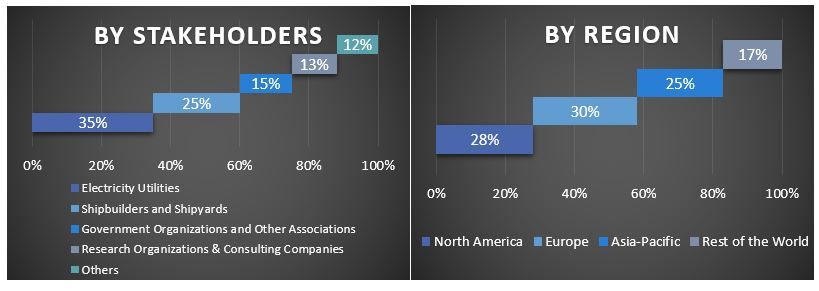
هندسة السوق
تم استخدام تقنية تثليث البيانات لإكمال تقدير السوق الإجمالي والوصول إلى أرقام إحصائية دقيقة لكل قطاع وقطاع فرعي في سوق السفن الكهربائية العالمي. تم تقسيم البيانات إلى عدة قطاعات وقطاعات فرعية بعد دراسة المعلمات والاتجاهات المختلفة في النوع والتطبيق والمناطق في سوق السفن الكهربائية العالمي.
الهدف الرئيسي لدراسة سوق السفن الكهربائية العالمي
تم تحديد اتجاهات السوق الحالية والمستقبلية لسوق السفن الكهربائية العالمي في الدراسة. يمكن للمستثمرين الحصول على رؤى استراتيجية لترسيخ تقديرهم للاستثمارات على التحليل النوعي والكمي الذي تم إجراؤه في الدراسة. حددت اتجاهات السوق الحالية والمستقبلية الجاذبية الإجمالية للسوق على المستوى الإقليمي، مما يوفر منصة للمشارك الصناعي لاستغلال السوق غير المستغلة للاستفادة من ميزة المبادرة. تشمل الأهداف الكمية الأخرى للدراسات ما يلي:
- تحليل حجم السوق الحالي والمتوقع لسوق السفن الكهربائية من حيث القيمة (بالدولار الأمريكي). أيضًا، قم بتحليل حجم السوق الحالي والمتوقع للقطاعات والقطاعات الفرعية المختلفة.
- تشمل القطاعات في الدراسة مجالات النوع والتطبيق والمناطق.
- تحديد وتحليل الإطار التنظيمي للسفن الكهربائية
- تحليل سلسلة القيمة المتضمنة مع وجود وسطاء مختلفين، إلى جانب تحليل سلوكيات العملاء والمنافسين في الصناعة.
- تحليل حجم السوق الحالي والمتوقع لسوق السفن الكهربائية للمنطقة الرئيسية.
- تشمل الدول الرئيسية في المناطق التي تمت دراستها في التقرير منطقة آسيا والمحيط الهادئ وأوروبا وأمريكا الشمالية وبقية العالم
- ملفات تعريف الشركة لسوق السفن الكهربائية واستراتيجيات النمو التي اعتمدها اللاعبون في السوق للاستمرار في السوق سريع النمو.
- تحليل متعمق على المستوى الإقليمي للصناعة
الأسئلة الشائعة الأسئلة الشائعة
س1: ما هو الحجم الحالي لسوق السفن الكهربائية العالمي وإمكانات نموه؟
س2: ما هي العوامل الدافعة لنمو سوق السفن الكهربائية العالمي؟
س3: أي قطاع لديه الحصة الأكبر في سوق Powership العالمي حسب النوع؟
س4: ما هي التقنيات والاتجاهات الناشئة في سوق Powership العالمي؟
س5: أي منطقة ستسيطر على سوق Powership العالمي؟
ذات صلة التقارير
العملاء الذين اشتروا هذا المنتج اشتروا أيضًا










